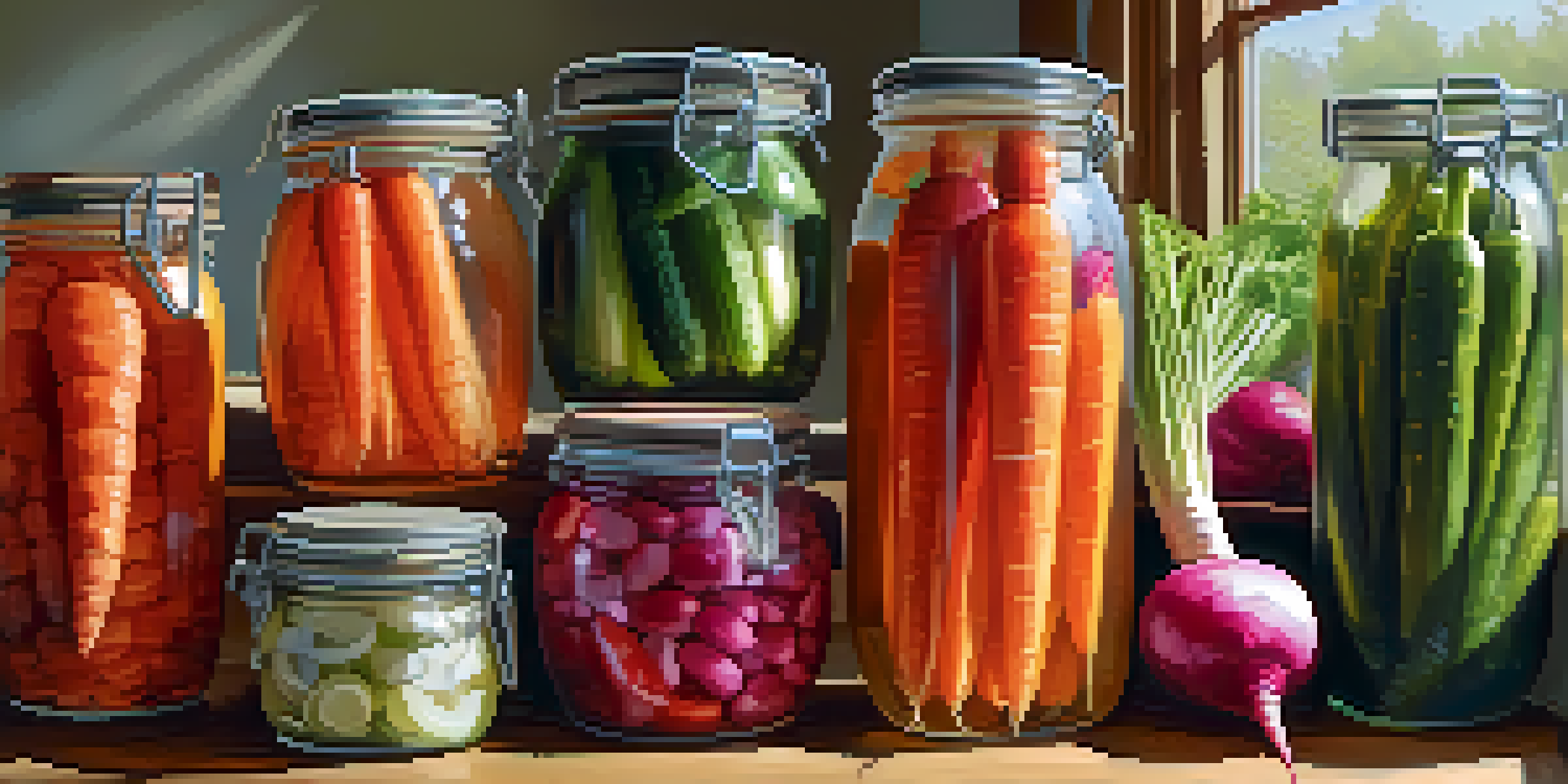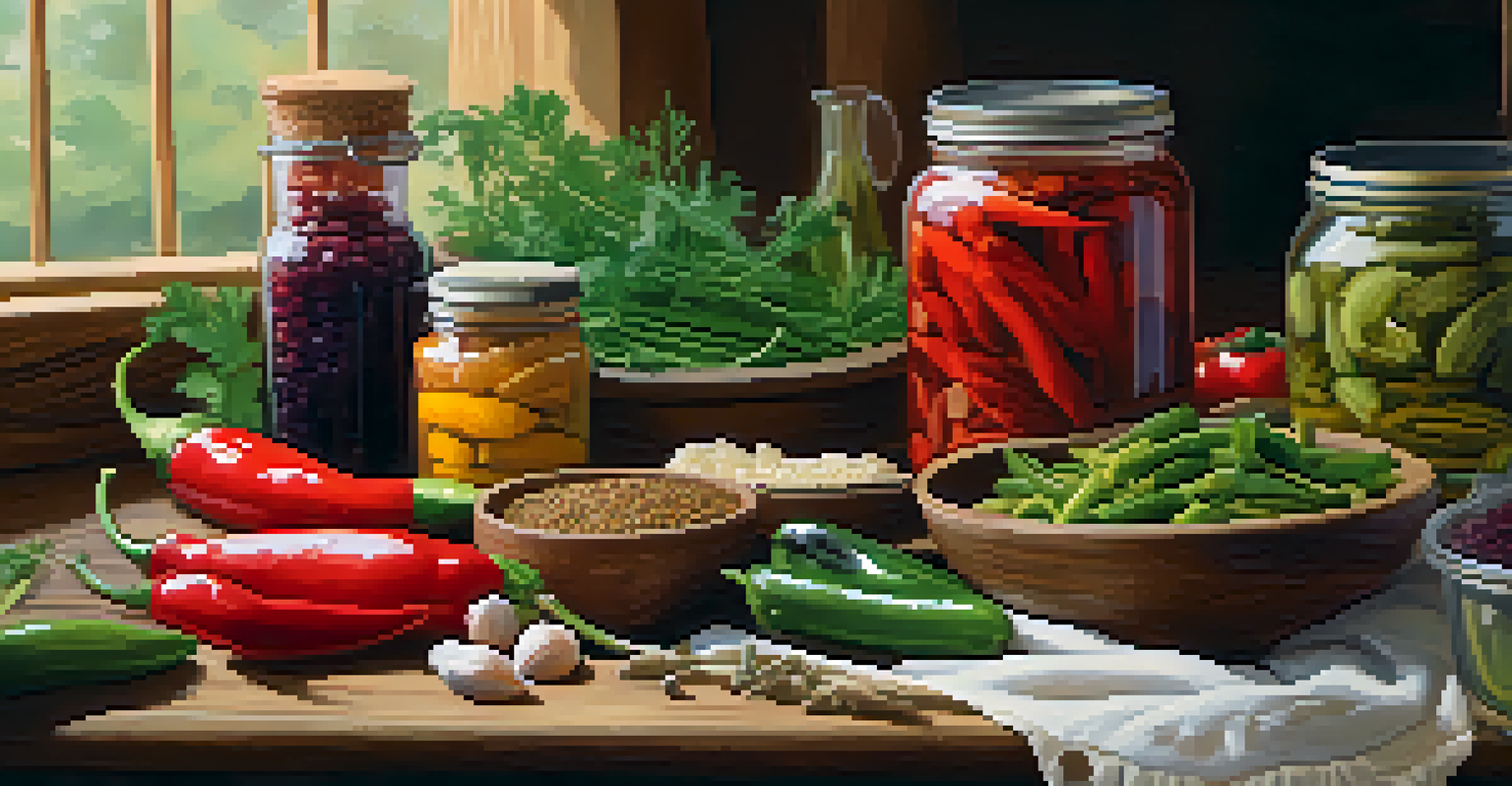Top 10 Vegetables Perfect for Fermenting at Home for Beginners

Why Fermenting Vegetables is a Great Idea for Beginners
Fermenting vegetables at home is a fun and rewarding process. Not only do you get to enjoy delicious flavors, but you also boost the nutritional value of your veggies. Fermentation creates probiotics, which are beneficial bacteria that support gut health.
Fermentation is the ultimate form of self-care. It's a way of creating health in your own kitchen.
Additionally, fermenting is a fantastic way to preserve your harvest or leftover produce. Instead of letting those veggies go to waste, you can transform them into tasty, tangy additions to your meals. Plus, it's a simple and approachable culinary skill that anyone can master with a little practice.
Finally, home fermentation allows for creativity. You can experiment with different spices, herbs, and flavor combinations, making it a personal journey that reflects your taste. So grab your jars and let’s dive into the top vegetables perfect for fermenting!
1. Cabbage: The Classic Fermented Vegetable
Cabbage is the star of the fermentation world, especially in the form of sauerkraut. Its high water content and natural sugars make it ideal for fermentation. Plus, it’s widely available and affordable, making it a perfect choice for beginners.

When fermenting cabbage, the process is straightforward: simply shred, salt, and pack it tightly into a jar. As it ferments, the cabbage will develop that signature tangy flavor that pairs beautifully with many dishes. It’s a staple on sandwiches, salads, and as a side dish.
Fermentation Boosts Nutrition
Fermenting vegetables enhances their nutritional value by creating beneficial probiotics that support gut health.
Not only is cabbage delicious, but it’s also packed with vitamins C and K. The fermentation process enhances its nutritional profile even further, making it a powerhouse vegetable to include in your diet.
2. Carrots: Crunchy and Colorful Ferments
Carrots are another fantastic option for those new to fermenting. They add a vibrant color and crunch to your fermented dishes. Their natural sweetness balances well with the tangy flavors developed during fermentation.
Food is not just what we eat; it’s what we ferment.
You can ferment carrots on their own or add spices like ginger, garlic, or dill for an extra kick. Just slice them into sticks or rounds, pack them into a jar, and cover with a saltwater brine. In just a few days, you’ll have a delicious and healthy snack.
Not only do fermented carrots taste great, but they’re also rich in beta-carotene, which supports eye health. This makes them a smart choice for both flavor and nutrition in your fermented creations.
3. Cucumbers: Pickles Made Easy
Cucumbers are perhaps the most recognizable fermented vegetable, often found in the form of pickles. Their high water content makes for a crisp and refreshing fermented treat. Plus, they’re one of the easiest vegetables to ferment, making them ideal for beginners.
Simply soak your cucumbers in a saltwater brine with your choice of spices, and let them ferment for a week or so. The result? Crunchy pickles that are perfect for snacking, adding to sandwiches, or enhancing salads.
Easy Vegetables for Beginners
Cabbage, carrots, and cucumbers are among the easiest vegetables to ferment, making them perfect choices for those new to the process.
What’s more, fermented cucumbers retain their hydrating properties while introducing beneficial probiotics into your diet. This makes them a tasty and healthful addition to any meal!
4. Radishes: Spicy and Flavorful Fermentation
Radishes might not be the first vegetable that comes to mind for fermentation, but they can create a delightful and spicy treat. Their natural peppery flavor becomes milder and more complex as they ferment, making them a unique addition to your pantry.
You can slice or chop radishes and mix them with other vegetables or spices for added flavor. The quick fermentation process usually takes just a few days, resulting in a crunchy, zesty side dish or topping.
Radishes are also low in calories but high in fiber and antioxidants. This means that not only are you enjoying a flavorful fermented food, but you're also boosting your health while doing so!
5. Beets: Sweet and Colorful Ferments
Beets add a beautiful splash of color to your fermented creations, plus they bring a subtle sweetness that balances tangy flavors. Fermented beets are not only visually stunning but also deliciously versatile, making them a great choice for beginners.
You can slice, grate, or even juice beets before fermenting, depending on your preference. They pair wonderfully with spices like caraway or dill, enhancing their already rich flavor. After a week or so, you’ll have a nutritious, tangy side dish.
Creative Flavor Combinations
Home fermentation allows for experimentation with spices and herbs, enabling you to create unique flavors that reflect your personal taste.
Beets are known for their health benefits, including improving blood flow and lowering blood pressure. Fermenting them further enhances their nutrients, making them a smart addition to your diet.
6. Green Beans: Crunchy and Versatile Ferments
Green beans are often overlooked when it comes to fermentation, but they can be a crunchy and delicious option. Their firm texture holds up well during the fermentation process, making them an ideal candidate for pickling.
Simply wash and trim the beans, pack them tightly in a jar, and cover with a saltwater brine. You can also add garlic, dill, or chili flakes for added flavor. After a week, you’ll have crispy, tangy green beans to enjoy.

Not to mention, fermented green beans are a fantastic source of vitamins A and C. They make a great snack on their own or can be used in salads and stir-fries.
7. Garlic: Flavorful Fermentation for the Bold
Garlic is a powerful flavor enhancer that can elevate your fermented dishes. While it’s often used as a seasoning, fermenting garlic creates a sweet, mellow flavor that can be a real treat for your taste buds.
You can ferment whole cloves or minced garlic, either on its own or mixed with other vegetables. The fermentation process transforms the sharpness of raw garlic into a smooth, rich flavor that can be used in various dishes.
Not only does fermented garlic taste amazing, but it’s also known for its health benefits, including boosting immunity and reducing inflammation. Incorporating fermented garlic into your diet can add both flavor and wellness to your meals.
8. Peppers: Spice Up Your Fermentation Game
Peppers, whether sweet or hot, can add a delightful kick to your fermented creations. They come in various colors and flavors, making them versatile for different palates. Fermenting peppers allows their natural sugars to develop deeper flavors.
You can slice bell peppers, or use whole hot peppers for a spicier option. Adding them to brines and letting them ferment can create tangy, spicy, or sweet flavors that enhance any dish. They’re excellent as toppings, in salads, or enjoyed straight from the jar.
Moreover, peppers are rich in vitamins A and C, making them not just delicious, but also a nutritious addition to your fermented lineup. So go ahead, spice things up and enjoy the flavors of fermented peppers!